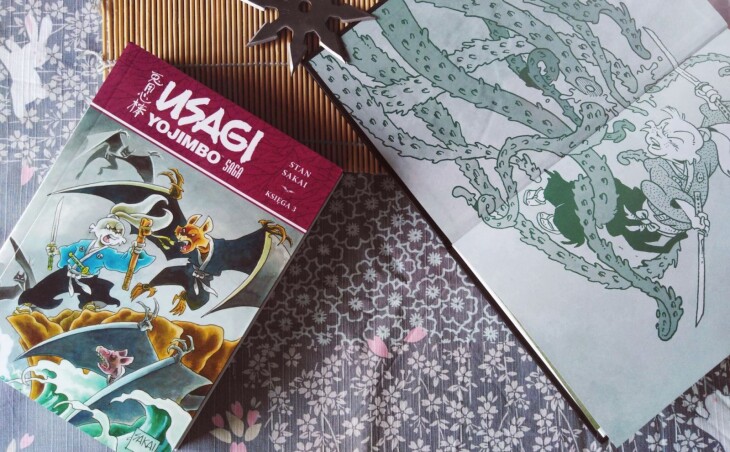Usagi Yojimbo is one of the best series on the Polish market. Here are seven reasons why you should read the story of the long-eared Ronin.
Lonely author and work
Sakai’s state creates Usagi practically alone. He makes up stories, writes scripts, draws and deals with lettering. He has complete control of the plot, characters and final form of his comic, which translates into its high quality.
For over 35 years of the series’ existence, only Sergio Aragonés, Tom Luth and Julie Fujii-Sakai helped him. The first of them came up with a plot for the Spirit of the General and inked a black and white version of Return to the Adachi Plain . The latter is responsible for the colors of most covers and some episodes (including the newest, published by IDW). In turn, Stan’s wife co-created episodes from the Chibi Usagi series about these versions of bohaets. Sakai does not mind that other creators will continue his work someday, while emphasizing that he does not intend to retire for now. Everything indicates that there are still many adventures of the samurai rabbit ahead of us.
Educational value
Stan Sakai is very serious about preparing to work on the story. From the cards of Usagi Yojimbo, we can learn, among other things, how samurai swords, decorative kimonos and festival kites were made, how they lived, what they ate and what was afraid of the seventeenth-century Japanese, and why Christians during the shogunate times had to hide their faith. The content-related correctness is so important to the author that when in one of the issues the readers noticed the placement of stones on the board for go that was inconsistent with the rules of the game, he decided to correct the drawing for the purposes of collective editions. As he emphasizes in interviews, the Internet turned out to be a blessing for him, which greatly accelerated and facilitated the search for the necessary sources of information and graphic materials.
Drawing Japan in light form
Feudal Japan appears relatively rarely in Western comics. The more it is worth appreciating the craftsmanship with which Sakai presents it. The author creates the world presented with great care. He knows very well how to compose frames and arrange drawings on the boards, so that the story has the right atmosphere and pace. He perfectly controls his cartoon style and is able to choose elements that are worth emphasizing and simplify or omit the less important ones. This makes his stories credible and emotional, despite the fact that their heroes are anthropomorphic animals.
Scenario inspirations
Saka differentiates individual episodes in terms of content and mood. He efficiently moves from comedy, through adventure, thriller and horror stories, to drama and moral historical story. He is often inspired by cinema, literature, comics, and above all, the culture and history of Japan. Miyamoto Usagi’s name is a reference to the famous swordsman Miyamoto Musashi, and the title of the series is Japanese for “rabbit adjutant” and a tribute to the film Yojimbo Akira Kurosawa.
On her way, Usagi meets a blind swordsman inspired by Zatoichi, a character of a warrior with a child referring to the manga Lone Wolf and a Puppy, as well as various Japanese ghosts and monsters. The idea to transfer Wells’s War of the Worlds to feudal Japan resulted in the Senso miniseries . On the other hand, Usagi in space, a comic book about a distant descendant of a long-eared Ronin, was an excuse for the author to draw a large number of his beloved dinosaurs.
Reading order
The undoubted advantage of the saga of the rabbit ronin is its flexibility in terms of where to start reading. For licensing reasons, Polish collective editions of Usagi Yojimbo were not published sequentially. Most readers in Poland started reading from volume 8, and only later did they learn about the earlier fate of the long-eared samurai. However, it does not bother you at all.
Most of Miyamoto Usagi’s adventures are autonomous stories enclosed in one or more notebooks that do not require a broader context. Although some plots or characters reappear in subsequent episodes, they are usually not crucial to understanding the plot.
Of course, the best starting point is the very beginning (literally: Usagi Yojimbo The Beginning. Book 1), but in fact, you can start with any volume in the main series. The Yokai album is good for that too. However, I would not recommend starting with the story of Senso or Usagi in Cosmos , which are a fantastic science variation and a kind of epilogue to the series.
The evolution of the hero, the world and the author
Reading Usagi Yojimbo in the order in which the episodes were published, you can see how this comic has changed and how its author has refined his technique and practice. Which does not mean, of course, that the first stories are weak – what’s not! The state of Sakai is of a high standard from the very beginning. However, you can see that with time both the scripts and the drawings become more sophisticated and complicated.
New release and availability
Usagi Yojimbo has been published in Poland since 2002. In the meantime, many parts have run out, and some have become white ravens at ridiculous aftermarket prices. Fortunately, new collective editions are currently being released. Usagi Yojimbo’s Beginning series will consist of two volumes corresponding to books 1-7, and Usagi Yojimbo Saga will consist of nine sections covering books 8-33. An additional advantage of this edition are the original onomatopoeias, hand-created by the author, and colorful illustrations from the covers of notebook issues.
I hope you got interested in Usagi’s adventures. And if you are curious where this hero came from and where he also appeared, check out my article Usagi Yojimbo – the genesis and fate of the samurai rabbit comic .

